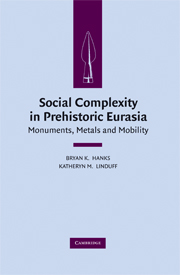Book contents
- Frontmatter
- Contents
- Contributors
- Foreword: From Myth to Method: Advances in the Archaeology of the Eurasian Steppe
- CHAPTER 1 Introduction: Reconsidering Steppe Social Complexity within World Prehistory
- PART ONE FRAMING COMPLEXITY
- PART TWO MINING, METALLURGY, AND TRADE
- PART THREE FRONTIERS AND BORDER DYNAMICS
- PART FOUR SOCIAL POWER, MONUMENTALITY, AND MOBILITY
- CHAPTER 17 Introduction
- CHAPTER 18 Re-writing Monumental Landscapes as Inner Asian Political Process
- CHAPTER 19 Socially Integrative Facilities and the Emergence of Societal Complexity on the Mongolian Steppe
- CHAPTER 20 Pre-Scythian Ceremonialism, Deer Stone Art, and Cultural Intensification in Northern Mongolia
- Index
CHAPTER 20 - Pre-Scythian Ceremonialism, Deer Stone Art, and Cultural Intensification in Northern Mongolia
from PART FOUR - SOCIAL POWER, MONUMENTALITY, AND MOBILITY
Published online by Cambridge University Press: 26 January 2010
- Frontmatter
- Contents
- Contributors
- Foreword: From Myth to Method: Advances in the Archaeology of the Eurasian Steppe
- CHAPTER 1 Introduction: Reconsidering Steppe Social Complexity within World Prehistory
- PART ONE FRAMING COMPLEXITY
- PART TWO MINING, METALLURGY, AND TRADE
- PART THREE FRONTIERS AND BORDER DYNAMICS
- PART FOUR SOCIAL POWER, MONUMENTALITY, AND MOBILITY
- CHAPTER 17 Introduction
- CHAPTER 18 Re-writing Monumental Landscapes as Inner Asian Political Process
- CHAPTER 19 Socially Integrative Facilities and the Emergence of Societal Complexity on the Mongolian Steppe
- CHAPTER 20 Pre-Scythian Ceremonialism, Deer Stone Art, and Cultural Intensification in Northern Mongolia
- Index
Summary
Deer stones and khirigsuur mounds are the most visible features of the archaeological landscape in the steppe region of northern Mongolia. Standing as slender stelae silhouetted against the sky and dark mounds against contoured landforms, deer stones and khirigsuurs evoke a past that contrasts with as much as it conforms to the lightdrenched landscape of gers and herders today. One world we see and understand; the other is only faintly visible through the stony remains of spiritual and ceremonial life. This chapter explores a time when stone men walked and spirits plied the mountaintops; when shamans sang, and warriors rode deer spirits to heaven. Once considered a marginal late-Scythian derivative, Mongolia's deer stones and khirigsuurs have recently been dated several hundred years earlier than Arzhan, and their elaborate burial mound architecture and artistic stone monuments indicate a level of socio-political intensification and complexity previously unknown among Bronze Age societies of the eastern steppe.
The Deer Stone–Khirigsuur Complex
The archaeology of central and eastern Asia has seen dramatic change during the past two decades. Some areas like Kazakhstan, Inner Mongolia, and Mongolia, which have been long closed to Western scholars, have become accessible now, while others like Tibet are almost completely unexplored.
- Type
- Chapter
- Information
- Social Complexity in Prehistoric EurasiaMonuments, Metals and Mobility, pp. 378 - 412Publisher: Cambridge University PressPrint publication year: 2009
- 14
- Cited by

